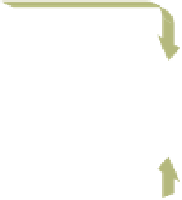Information Technology Reference
In-Depth Information
In addition to e-commerce, business information systems use telecommunications and
the Internet to perform many related tasks.
Electronic procurement (e-procurement)
, for ex-
ample, involves using information systems and the Internet to acquire parts and supplies.
Electronic business (e-business)
goes beyond e-commerce and e-procurement by using in-
formation systems and the Internet to perform all business-related tasks and functions, such
as accounting, finance, marketing, manufacturing, and human resource activities. E-business
also includes working with customers, suppliers, strategic partners, and stakeholders. Com-
pared to traditional business strategy, e-business strategy is flexible and adaptable (see
Figure 1.10).
electronic business
(e-business)
Using information systems and the
Internet to perform all business-
related tasks and functions.
E-BUSINESS
Figure 1.10
Electronic Business
E-business goes beyond
e-commerce to include using
information systems and the
Internet to perform all business-
related tasks and functions, such as
accounting, finance, marketing,
manufacturing, and human
resources activities.
Management
Suppliers
E-procurement
Organization
and its partners
Customers
E-commerce
Enterprise Systems: Transaction Processing Systems and
Enterprise Resource Planning
Transaction Processing Systems
Since the 1950s, computers have been used to perform common business applications. Many
of these early systems were designed to reduce costs by automating routine, labor-intensive
business transactions. A
transaction
is any business-related exchange such as payments to
employees, sales to customers, or payments to suppliers. Thus, processing business transac-
tions was the first computer application developed for most organizations. A
transaction
processing system (TPS)
is an organized collection of people, procedures, software,
databases, and devices used to record completed business transactions. If you understand a
transaction processing system, you understand basic business operations and functions.
One of the first business systems to be computerized was the payroll system (see
Figure 1.11). The primary inputs for a payroll TPS are the number of employee hours worked
during the week and the pay rate. The primary output consists of paychecks. Early payroll
system produces employee paychecks and related reports required by state and federal agen-
cies, such as the Internal Revenue Service. Other routine applications include sales ordering,
customer billing and customer relationship management, and inventory control. Some au-
tomobile companies, for example, use their TPSs to buy billions of dollars of needed parts
each year through Internet sites. Because these systems handle and process daily business
exchanges, or transactions, they are all classified as TPSs.
transaction
Any business-related exchange,
such as payments to employees,
sales to customers, and payments
to suppliers.
transaction processing system
(TPS)
An organized collection of people,
procedures, software, databases,
and devices used to record
completed business transactions.
Figure 1.11
Hours
worked
A Payroll Transaction
Processing System
In a payroll TPS, the inputs
(numbers of employee hours
worked and pay rates) go through a
transformation process to produce
outputs (paychecks).
Payroll
transaction
processing
Payroll
checks
Pay
rate















